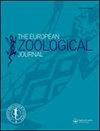COVID-19大流行期间华沙狍(Capreolus Capreolus)日常活动模式的变化
IF 1.4
4区 生物学
Q2 ZOOLOGY
引用次数: 4
摘要
摘要新冠肺炎大流行改变了游客对城市森林和绿地的访问水平,为衡量人类活动对野生动物及其活动的影响提供了一个独特的机会。我们研究的目的是描述与2019年同期(对照年)相比,2020年(新冠肺炎大流行宣布的那一年)华沙城市森林中,随着游客频率的变化,roe鹿的日常活动模式(即昼夜观察的比例)是如何变化的。在这两个年份里,总共有662次通过相机捕捉到的对鱼子的观察。2019年3月至2020年(封锁前,游客数量没有变化),华沙城市森林中白天和晚上观察到的鹿的频率没有变化。接下来,在2020年4月1日至20日期间(全国封锁;城市森林对公众关闭),马鹿的活动在白天增加。在2019年和2020年的4月21日至6月30日期间,在白天和晚上观察鹿的频率没有差异(绿色区域重新开放,远程学习)。最后,在2020年7月至8月(暑假期间,森林中的旅游交通量全天都在增加),獐的活动在夜间明显增加。我们的研究表明,在封锁后,他们的活动如何迅速转向白天森林对游客关闭的时候,以及夜间城市森林的游客数量更高的时候。总之,在新冠肺炎大流行期间,城市森林中的马鹿对人类的存在表现出高度的生态可塑性,并迅速适应城市森林游客数量的变化。本文章由计算机程序翻译,如有差异,请以英文原文为准。
Changes in roe deer (Capreolus capreolus) daily activity patterns in Warsaw during the COVID-19 pandemic
Abstract The COVID-19 pandemic, which modified levels of visitor attendance to urban forests and green spaces, provided a unique opportunity to measure the effects of human presence on wild animals and their activity. The aim of our study was to describe how the daily activity pattern of roe deer (i.e. proportion of day- and night-time observations) changed in response to visitor frequency in urban forests of Warsaw in four periods of 2020 (the year the COVID-19 pandemic was announced) compared to the same periods in 2019 (control year). In total, 662 observations of roe deer were recorded by camera traps in both years. The frequency of roe deer observations in urban forests of Warsaw in day- and night-time did not differ between March 2019 and 2020 (period before lockdown, no changes in the number of visitors). Next, between 1 and 20 April 2020 (national lockdown; urban forests were closed for public) the activity of roe deer increased during the day-time. Between 21 April and 30 June in both 2019 and 2020 the frequency of roe deer observations in day and night-time did not differ (green areas were reopened, remote learning). Finally, in July–August 2020 (summer holidays, tourist traffic in forests elevated all day round) the activity of roe deer visibly increased during the night-time. Our research shows how their activity rapidly shifted toward day-time when forests were closed for visitors, and toward night-time when the number of visitors was higher in urban forests after the lockdown. To summarize, roe deer in urban forests showed high ecological plasticity to human presence and rapidly adjusted to changes in the number of visitors in urban forest during the COVID-19 pandemic.
求助全文
通过发布文献求助,成功后即可免费获取论文全文。
去求助
来源期刊

European Zoological Journal
Agricultural and Biological Sciences-Animal Science and Zoology
CiteScore
3.10
自引率
5.60%
发文量
80
审稿时长
30 weeks
期刊介绍:
The European Zoological Journal (previously Italian Journal of Zoology) is an open access journal devoted to the study of all aspects of basic, comparative and applied protozoan and animal biology at molecular, cellular, tissue, organ, organismal, population, and community-ecosystem level. Papers covering multiple levels of organization and integrative approaches to study animal form, function, development, ecology, evolution and systematics are welcome. First established in 1930 under the name of Il Bollettino di Zoologia, the journal now has an international focus, reflected through its global editorial board, and wide author and readership.
 求助内容:
求助内容: 应助结果提醒方式:
应助结果提醒方式:


